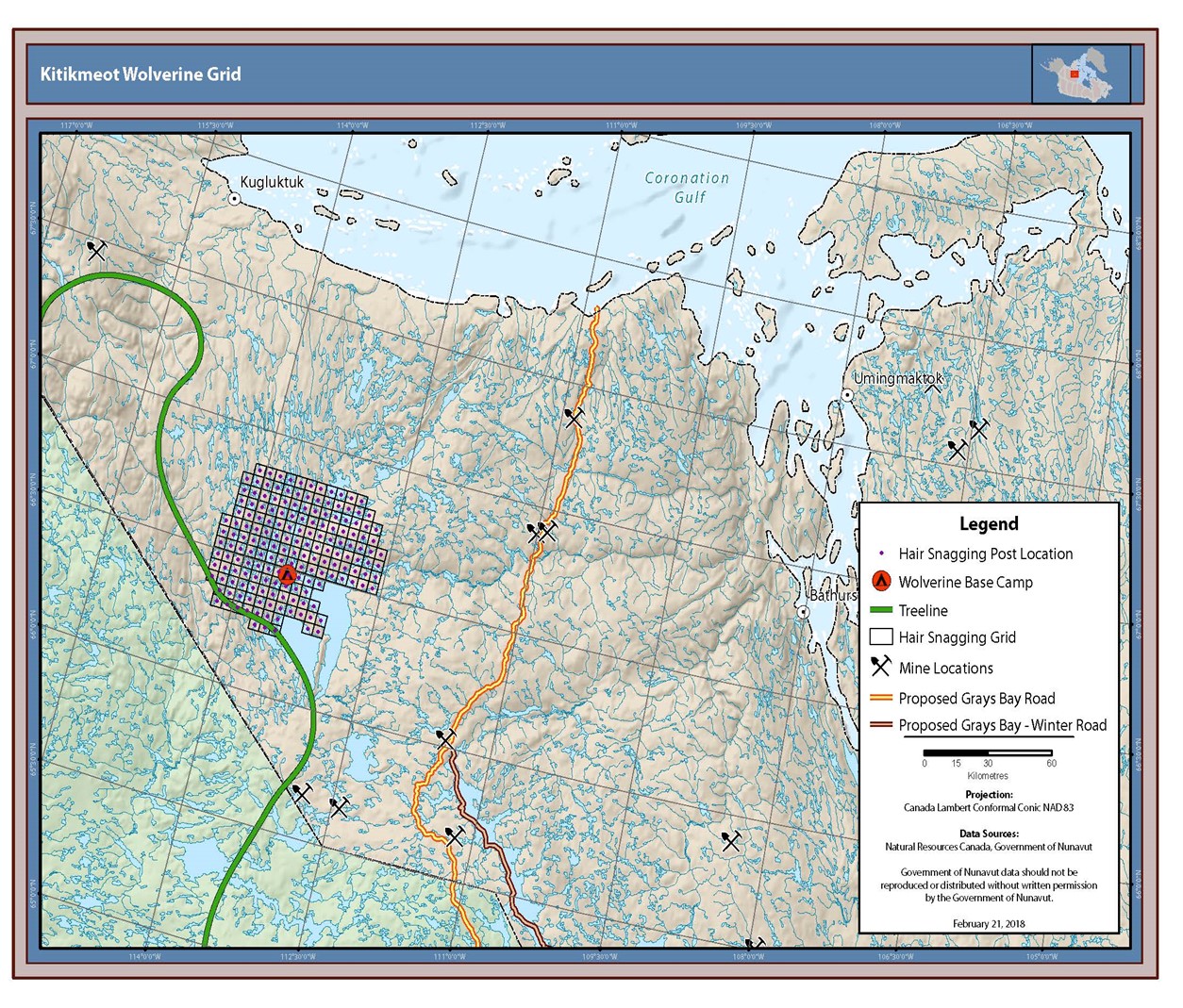Kitikmeot wolverines monitoring: A non-invasive and community-based initiative
Author
- M. Awan, Department of Environment, Government of Nunavut, Nunavut, Canada, and Kugluktuk Angoniatit Association, Hunters and Trappers Organization, Nunavut, Canada, mawan@gov.nu.ca
Citation information
Awan, M. 2020. Kitikmeot wolverines monitoring: A non-invasive and community-based initiative. Polar Knowledge: Aqhaliat Report, volume3, Polar Knowledge Canada, p. 58–61. DOI: 10.35298/pkc.2020.14.eng
Article
Wolverine is an important cultural and economic resource traditionally harvested by Inuit. This report presents results for a wolverine (Gulo gulo) DNA mark-recapture study conducted near Napaktulik Lake, Kitikmeot region, Nunavut, to establish baseline population abundance and density estimates for long-term regional monitoring. In addition, monitoring of the wolverine population is also important as part of predator research and management as it informs caribou management. Wolverines are listed as a species of Special Concern under the federal Species at Risk Act. This project was done collaboratively with the Kugluktuk (Angoniatit Association) Hunters and Trappers Organization (HTO).
Genetic analysis was used to identify individual wolverines and their sex from hair samples collected non-invasively by a science-driven study design and logistics that was facilitated by local hunters. From early March through late April 2018 and 2019, the field team sampled a grid of 154 posts baited with caribou (Rangifer tarandus groenlandicus) and muskox (Ovibos moschatus) legs and scent lures. The posts were spaced in 5 x 5 kilometres (km) (i.e., 25 kilometres squared (km2)) cells for three 10-day sessions within a 4,000 km2 area northwest of Napaktulik Lake.
In total, 22 individual wolverines (11 Females (F) : 11 Males (M)) were detected in 2018 and 27 wolverines in 2019 (13F:14M), including 10 individuals (6F:4M) that were first identified in 2018, and then recaptured in 2019. Spatially explicit capture-recapture (SECR) methods were used to estimate population density. Wolverine density was estimated as 3.10 wolverines/1,000 km2 in 2018 and 4.14 wolverines/1 000 km2 in 2019, with no significant difference between these years. These SECR yearly density estimates pertain only to wolverines with home range centers within the DNA sampling grid. Our results suggest that the population of wolverines in the proximity of the grid varies spatially and temporally in its usage of the grid area, which may be responsible for the apparent interannual variation in density estimates. There was little difference between sexes in the extent of movements on the grid in 2018, but a clear separation in 2019. Median observed range length of detected males (24 km) was similar to that of detected females (23 km) in 2018, but consistently larger in 2019. Wolverines in the region exist at low densities and are being exposed to increasing levels of human activity. This collaborative research project with the Kugluktuk Hunters and Trappers Organization has provided valued training, employment, and technical skills for HTO members. By involving local hunters, DNA-based surveys offer a practical and cost-effective method to monitor wolverine populations in tundra environments. For a better understanding of wolverine population in the area, long-term monitoring by involving local HTOs and industry is recommended. This study demonstrates the efficiency of joint research projects to inform wildlife management.
Wolverines in the region exist at low densities and are being exposed to increasing levels of human activity through mining and subsistence harvest. Our results, which contribute to baseline data for wolverine ecology, could be used to provide a quantitative basis to establish future sustainable harvest limits and could support input to the Nunavut Impact Review Board review process. DNA based surveys offer a practical and cost-effective method to monitor wolverine populations in tundra situations. For a better understanding of wolverine population in the area, we recommend long term monitoring by involving local HTOs and industry. This study demonstrates the efficiency of joint research projects to inform wildlife management.
Key words: Density estimates, DNA, Gulo gulo, HTO, Napaktulik Lake, Kitikmeot, Nunavut, Spatially Explicit Capture Recapture, Wolverine.

Figure 1: Wolverine 2018-2019 DNA sampling grid.

Figure 2: Wolverine study area.

Figure 3: Preparation and deployment of hair-snag posts within the study area.

Figure 4: Hair snag posts with visitors and wolverine hair samples.
Acknowledgements
Field team:
- Malik Awan, GN Department of Environment;
- O.J. Bernhardt, Kugluktuk HTO member (2018);
- Eric Hitkolok, Kugluktuk HTO member (2019);
- Perry Klengenberg, Kugluktuk HTO member; and
- Jonathan Niptanatiak, Kugluktuk HTO member.
Funding sources
- Government of Nunavut, Department of Environment;
- Nunavut Wildlife Management Board (NWMB); and
- Polar Knowledge Canada.
Polar Knowledge Canada
For media inquiries, contact:
communications@polar-polaire.gc.ca
Page details
- Date modified: